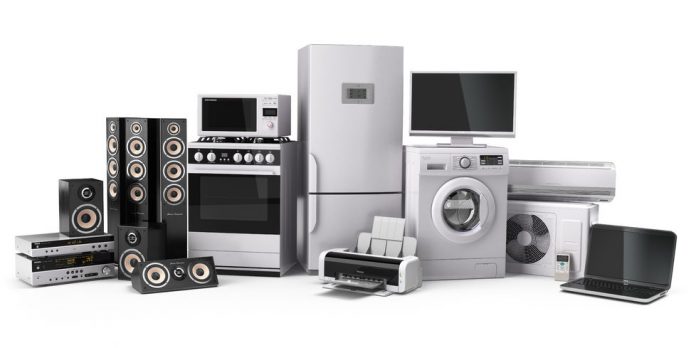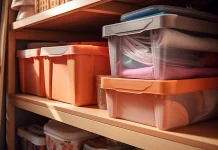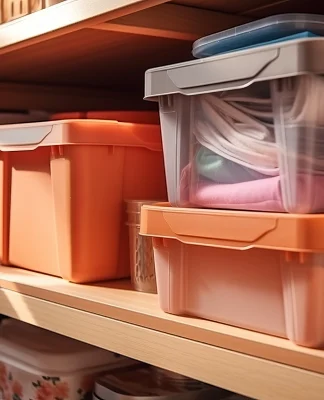Electronics are expensive. When you’re using them, you always keep them in the best condition possible. The same concept should be applied when you put them in storage. If you don’t focus on storing your electronics safely, you’ll end up needing unplanned and expensive replacements, which is never ideal.
The first step to take to store electronics is to prepare. In fact, you can never be too prepared. Since the cost of electronics adds up fast, and they can contain a lot of personal information, you’ll want to take your time here.
1. Always Back Up Your Data
 Before doing anything, you should always make it a priority to back-up your data. Regardless of if your computer is new or old, has limited cloud storage or not, backing up your data is the best way to ensure that you don’t lose anything during storage. Preparing for the worst case scenario is better than scrambling around and trying to figure out a way to get back 20 years of family pictures or business records. Luckily, backing up your data is easy. Simply buy an external hard drive that has enough storage space for your data. Once you back-up your information, always store it off-site. You can pay for cloud service; just make sure it’s big enough rather than a few free GB that comes with computers.
Before doing anything, you should always make it a priority to back-up your data. Regardless of if your computer is new or old, has limited cloud storage or not, backing up your data is the best way to ensure that you don’t lose anything during storage. Preparing for the worst case scenario is better than scrambling around and trying to figure out a way to get back 20 years of family pictures or business records. Luckily, backing up your data is easy. Simply buy an external hard drive that has enough storage space for your data. Once you back-up your information, always store it off-site. You can pay for cloud service; just make sure it’s big enough rather than a few free GB that comes with computers.
2. Familiarize Yourself with the Manual
 Remember that big, heavy manual that your TV or computer came with? Did you throw it away? If not, get it out. Read through it and see if there are any specific instructions for how to store each of your specific electronic devices and if there are, follow them. If you’ve misplaced your manual (a.k.a., threw it away) see if you can look it up online. Now a days, almost every electronic offers a digital version of the manual—one that’s usually searchable and easier to handle. Adhering to the instructions in a user manual will ensure you properly store each item.
Remember that big, heavy manual that your TV or computer came with? Did you throw it away? If not, get it out. Read through it and see if there are any specific instructions for how to store each of your specific electronic devices and if there are, follow them. If you’ve misplaced your manual (a.k.a., threw it away) see if you can look it up online. Now a days, almost every electronic offers a digital version of the manual—one that’s usually searchable and easier to handle. Adhering to the instructions in a user manual will ensure you properly store each item.
3. Take Apart Electronics if Needed
Many electronics come with a lot of moving parts. Instead of just throwing the whole thing inside of your self storage unit, take the time to separate it. This will help keep things clean and in their best condition. Remove things that would rust or potentially get stuck together over time and always stay organized throughout the process.
4. Clean Each Individual Piece
Dirt and dust on electronics is harmless if it sits overnight, but if you’re leaving your things in storage for months or even years, dirt can be your worst nightmare. It can get under keypads and buttons and create the perfect breeding ground for pests. It can even end up ruining your devices over time. Rather than risk it, always clean each individual piece of your electronics after taking them apart. Since you’ve already done the first step, wiping things down should be easy. Clean visible, and non-visible, dirt, dust, and grime. Be thorough and use compressed air to get into hard-to-reach areas. There are also a number of specific electronic cleansers on the market for different devices you’re focusing on.
After you’ve cleaned everything, cover monitors and screens with padding to avoid accidents and the heavy accumulation of dust.
Storage Tips
After preparing your electronic devices, it’s time to start getting things organized for storage. With a few simple measures, you’ll transform your self storage unit into your very own professional electronics warehouse.
Make an Inventory
 This is high on all of our storage to-do lists because staying organized helps you keep your sanity. Go through all of the electronics you’ll be storing and create a detailed inventory of what you have. Include remotes, cables, and any other accessories that go with each item. In this inventory, write down the respective serial numbers for each of your devices so you can easily refer to the user manuals or warranties if needed. If there are specific notes about a particular electronic device, include them in your inventory to help you remember details when unpacking your storage unit.
This is high on all of our storage to-do lists because staying organized helps you keep your sanity. Go through all of the electronics you’ll be storing and create a detailed inventory of what you have. Include remotes, cables, and any other accessories that go with each item. In this inventory, write down the respective serial numbers for each of your devices so you can easily refer to the user manuals or warranties if needed. If there are specific notes about a particular electronic device, include them in your inventory to help you remember details when unpacking your storage unit.
With your inventory ready, take the time to label each and every electronic and all of the corresponding parts. If things get separated, for whatever reason, it’s much easier to reconnect the right pieces when they’re labeled. Even if you think you’ll be able to tell what is what, just label it. Believe us, taking a few extra minutes here is much easier than trying to sort everything out months or even years down the line.
Store Wires Separately
 Some bundle of cables or wires will accompany almost every single electronic device. While they serve a purpose when the electronic device is in use, it’s not a good idea to store them connected. This is because cables can seize and rust in the sockets causing them to stop working. When it’s the only video input port, this can mean having to purchase a whole new TV. Instead of risking the damage, take the time to remove any and all cables from your electronic devices. This includes USB cables, video and audio cables, HDMI cables, and more. For each device, wrap all of the cables together, attach them at the middle with masking tape, and label which device they belong to. This way, you won’t have to try and piece puzzles together when you take them out of storage.
Some bundle of cables or wires will accompany almost every single electronic device. While they serve a purpose when the electronic device is in use, it’s not a good idea to store them connected. This is because cables can seize and rust in the sockets causing them to stop working. When it’s the only video input port, this can mean having to purchase a whole new TV. Instead of risking the damage, take the time to remove any and all cables from your electronic devices. This includes USB cables, video and audio cables, HDMI cables, and more. For each device, wrap all of the cables together, attach them at the middle with masking tape, and label which device they belong to. This way, you won’t have to try and piece puzzles together when you take them out of storage.
Remove All Batteries
 Regardless of what kind of storage unit you’re using, you should never store the batteries intact. Batteries can quickly start to omit corrosive material and are a huge risk to things they’re stored in or around. If you keep your batteries in your electronic devices, chances are high that they will be ruined when you bring them out of storage. Plus, the battery acid that leaks can be extremely harmful and a little more than annoying to clean. This is especially true of common, household AA batteries. If you want to store laptop or camera batteries, we recommend taking them out of the device and storing them separately in case of any damage.
Regardless of what kind of storage unit you’re using, you should never store the batteries intact. Batteries can quickly start to omit corrosive material and are a huge risk to things they’re stored in or around. If you keep your batteries in your electronic devices, chances are high that they will be ruined when you bring them out of storage. Plus, the battery acid that leaks can be extremely harmful and a little more than annoying to clean. This is especially true of common, household AA batteries. If you want to store laptop or camera batteries, we recommend taking them out of the device and storing them separately in case of any damage.
Look for Original Packaging
 If you’re one of those people that has a hard time throwing things out—like original boxes—good for you! That will come in handy when packing up your electronics. The original packaging is the best place to store your electronics because they fit perfectly and were specifically designed to keep the individual electronic safe and sound. If you don’t have original packaging, look for boxes that are close to the same size as the electronic you’re storing. Throw in some static-free, special bubble wrap for an added layer of protection, but avoid plastic sheeting.
If you’re one of those people that has a hard time throwing things out—like original boxes—good for you! That will come in handy when packing up your electronics. The original packaging is the best place to store your electronics because they fit perfectly and were specifically designed to keep the individual electronic safe and sound. If you don’t have original packaging, look for boxes that are close to the same size as the electronic you’re storing. Throw in some static-free, special bubble wrap for an added layer of protection, but avoid plastic sheeting.
Plastic sheeting is a water proof material that many people assume will add a layer of protection. It does the opposite. Plastic sheeting doesn’t allow things to breathe, so it will keep any water or moisture inside of your electronics and when you go to open your unit, you’ll be in for an expensive surprise.
If you have a large amount of small boxes of electronics, consider putting them in one larger box—as long as it doesn’t make it too heavy. Then, label the box with its contents so you know exactly what’s inside when you need to find it.
Storing Small Electronics vs. Large Electronics
The only main difference about storing small electronics versus large ones is how you’ll put them in your storage unit. Smaller units can be placed into a larger box together after packed individually, while large ones should be kept independently from each other. If things are heavy or expensive, such as dryers, washers, refrigerators, and any large televisions, take extra precaution with them.
Get a Climate Controlled Self Storage Unit
Electronics are delicate and expensive to repair or replace. Instead of risking them getting ruined, store them with confidence in a climate controlled self storage unit. Leaving them in places that are subject to extreme elements is the farthest thing from ideal and will quickly cause them to break. Instead, opt for a self storage unit that is climate controlled and create a storage layout that allows electronics to be stored off the ground.
If you’re looking for a place to store all of your electronic devices safely, look no further than The Lock Up Self Storage. All of our units are climate controlled, which means you’ll have the perfect year-round temperatures and humidity control to keep things working like new. Our self storage units are also protected by state-of-the-art security measures, so you can rest easy knowing your things are in good hands. Our security system includes 24/7 video monitoring, individually coded access gates, a full perimeter alarm, and motion-sensor lighting systems. Regardless of your storage needs, you’ll be able to find something at The Lock Up. We have a variety of sizes of self storage units and flexible leases so you can upgrade to a larger space when your needs change. If you’re looking for a self storage unit, The Lock Up Self Storage is here to help. Head over to https://www.thelockup.com today and check out our available units or stop by any of our locations to speak with a representative.



















